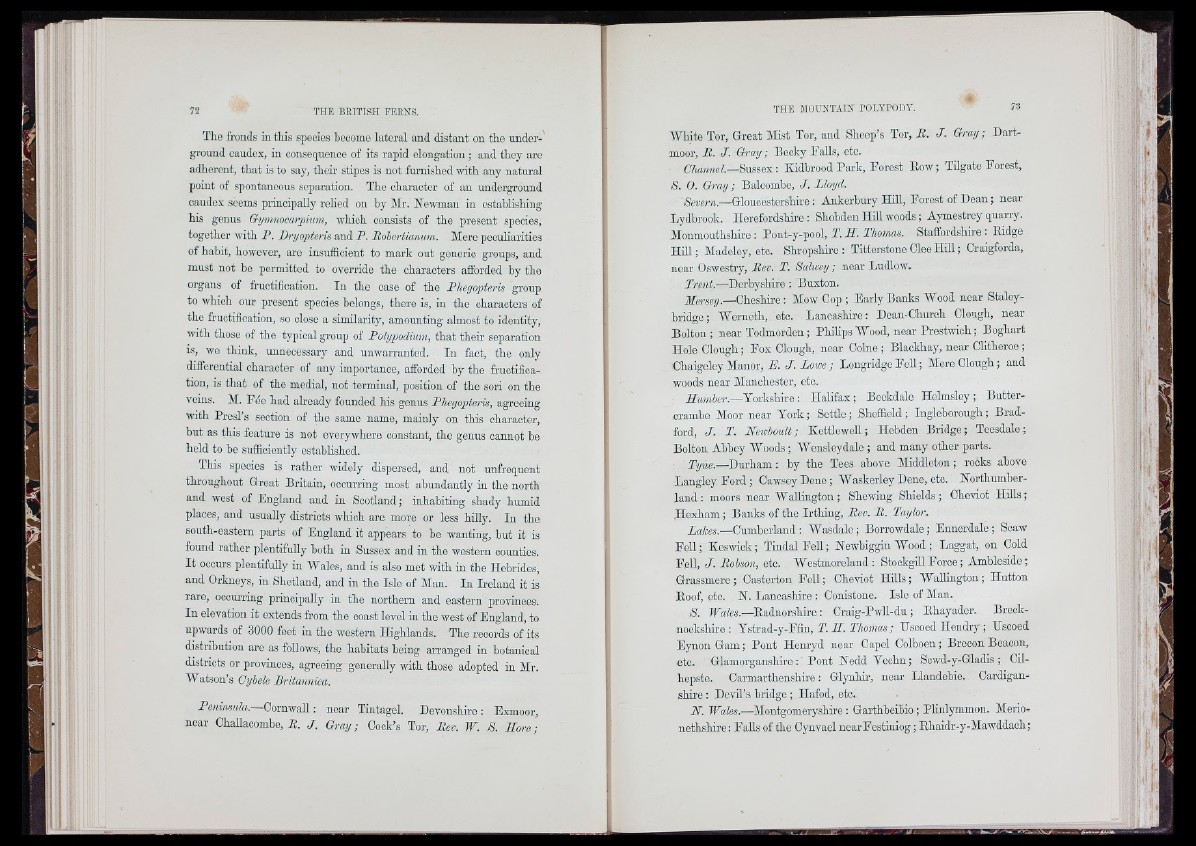
iil
The fronds in this species become lateral and distant on the underground
caudex, in consequence of its rapid elongation ; and they aro
adherent, tliat is to say, thoir stipes is not furnished with any natural
point of spontaneous separation. Tho character of an underground
caudex seems principally reHed on by Mr. Newman in establishing
his genus Gymnocarpinm, which consists of the present species,
together with P . Dryopteris and P . Rohertianim. Mere peculiarities
of habit, however, are insufficient to mark out generic groups, and
must not be permitted to override the characters afforded by the
organs of fructification. In the case of the Phegopteris group
to which our present species belongs, there is, in the characters of
the fructification, so close a similarity, amounting almost to identity,
with thoso of the typical group of Polypodium, that thoir separation
is, wo think, unnecessary and unwarranted. In fact, the only
diiforontial character of any importance, afibrded by the fructification,
is that of the medial, not terminal, position of the sori on the
veins. M. Fée had already founded his genus Phegopteris, agreeing
with PresTs section of the same name, mainly on this oharaoter,
but as this feature is not everywhere constant, the genus cannot be
held to be sufficiently established.
This species is rather widely dispersed, and not unfrequent
throughout Great Britain, occurring most abundantly in the north
and west of England and in Scotland; inhabiting shady humid
places, and usually districts which aro more or less hilly. In the
south-eastern parts of England it appears to bo wanting, but it is
found rather plentifully both in Sussex and in the western counties.
I t occurs ifientifidly in Wales, and is also met with in the Hebrides,
and Orkneys, iu Shetland, and in the Isle of Man. In Ireland it is
rare, occurring principally in the northern and eastern provinces.
In elevation it extends from the coast level in the west of England, to
upwards of 3000 feet in the western Highlands. The records of its
distribution are as follows, the habitats being arranged in botanical
districts or provinces, agreeing generally with those adopted in Mr.
Watson’s Cybele Britannica.
Peninsula. Cornwall : near Tintagel. Devonshire : Exmoor,
near Challacombe, P . J . Gray ; Cook’s Tor, Bev. W. 8. Ilore ;
White Tor, Great ilis t Tor, and Sheep’s Tor, B . J . Gray; Dartmoor,
R. J . Gray ; Becky Falls, etc.
Sussex : Kidbrood Park, Forest Row; Tilgato Forest,
S. 0. Gray ; Balcomho, J . Lloyd.
iSerer».—Gloucestershire ; Ankerbury Hill, Forest of Dean ; near
Lydbrook. Herefordshire; Shobden Hill woods ; Aymestrey quarry.
Monmouthshire : Pont-y-pool, T. II . Thomas. Staffordshire : Ridge
H ill; Madeloy, etc. Shropshire: Titterstone Glee Hill ; Craigforda,
near Oswestry, Rev. T: Salivey ; near Ludlow.
Trent.—Derbyshire : Buxton.
Mersey.—Cheshire : Mow Cop ; Early Banks Wood near Staley-
hridge; Wernoth, etc. Lancashire: Doan-Church Clough, near
Bolton; near Todmorden ; Philips Wood, near Prestwioh ; Boghart
Hole Clough ; Fox Clough, near Colne ; Blaokhay, near Clitheroe ;
Chaigeloy Manor, E. J . Lowe; Longridge Fell ; Mere Clough; and
woods near Manchester, etc.
Hiiwiier.—Yorkshire ; Halifax; Beckdale Ilelmsley ; Butter-
orambe Moor near York; Settle; Sheffield; Inglohorough; Bradford,
J . T. Newboidt; Kettlewell; Hebden Bridge; Toesdalo;
Bolton Abbey Woods ; Wensleydalo ; and many other parts.
Tyne.—Durham; by the Tees above Middleton; roCks above
Langley Ford ; CawsoyDene; Waskerley Dene, etc. Northumberlan
d : moors near Wallington ; Shewing Shields; Cheviot Hills;
Hexham ; Banks of the Irthing, Rev. B . Taylor.
Bakes.—Cumberland : Wasdale ; Borrowdale ; Ennerdale ; Soaw
F e ll; Keswick; T in d a lF e ll; Newbiggin Wood ; Laggat, on Cold
Fell, J . Robson, etc. Westmoreland: Stookgill Force ; Ambleside;
Grassmere ; Oasterton F e ll; Cheviot Hills; Wallington; Hutton
Roof, etc. N. Lancashire : Conistone. Isle of Man.
S. Wales.—Radnorshire : Craig-Pwll-du ; Rhayader. Brecknockshire
: Ystrai-'y-L'fui, T. IT. Thomas ; Hsooed Hendry ; Hscoed
Eynoii Gam ; Pont Ilenryd near Capei Colboen ; Brecon Beacon,
etc. Glamorganshire : Pont Nedd Vechn ; Scwd-y-Gladis ; Cil-
hepste. Carmarthenshire : Glynhir, near Llandobie. Cardiganshire
: Devil’s bridge ; Hafod, etc.
A. Wales.—Montgomeryshire : Garthbeibio ; Plinlymmon. Merio-
netbshire : FaUs of the Cynvael nearFestiniog ; Rhaidr-y-Mawddach;